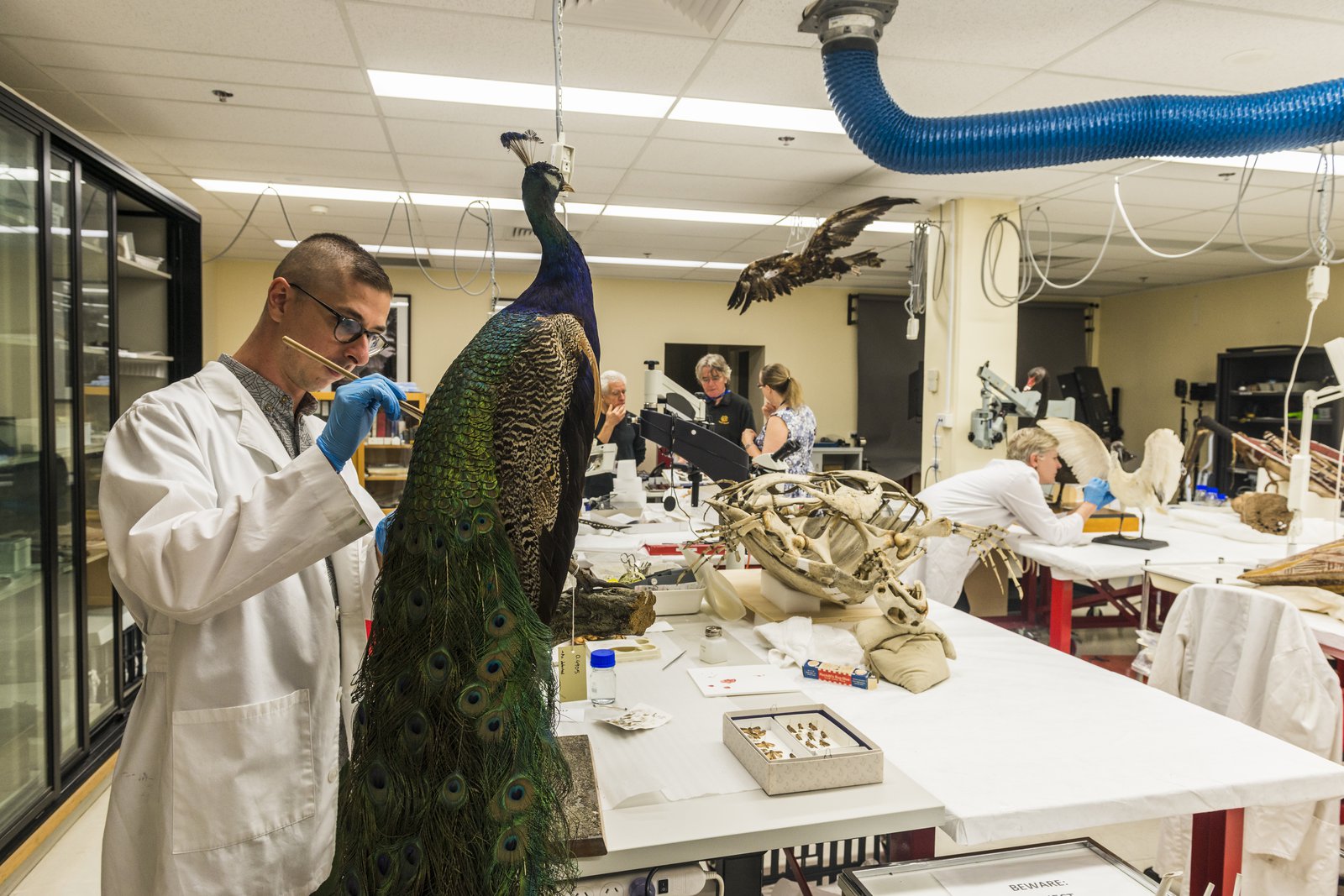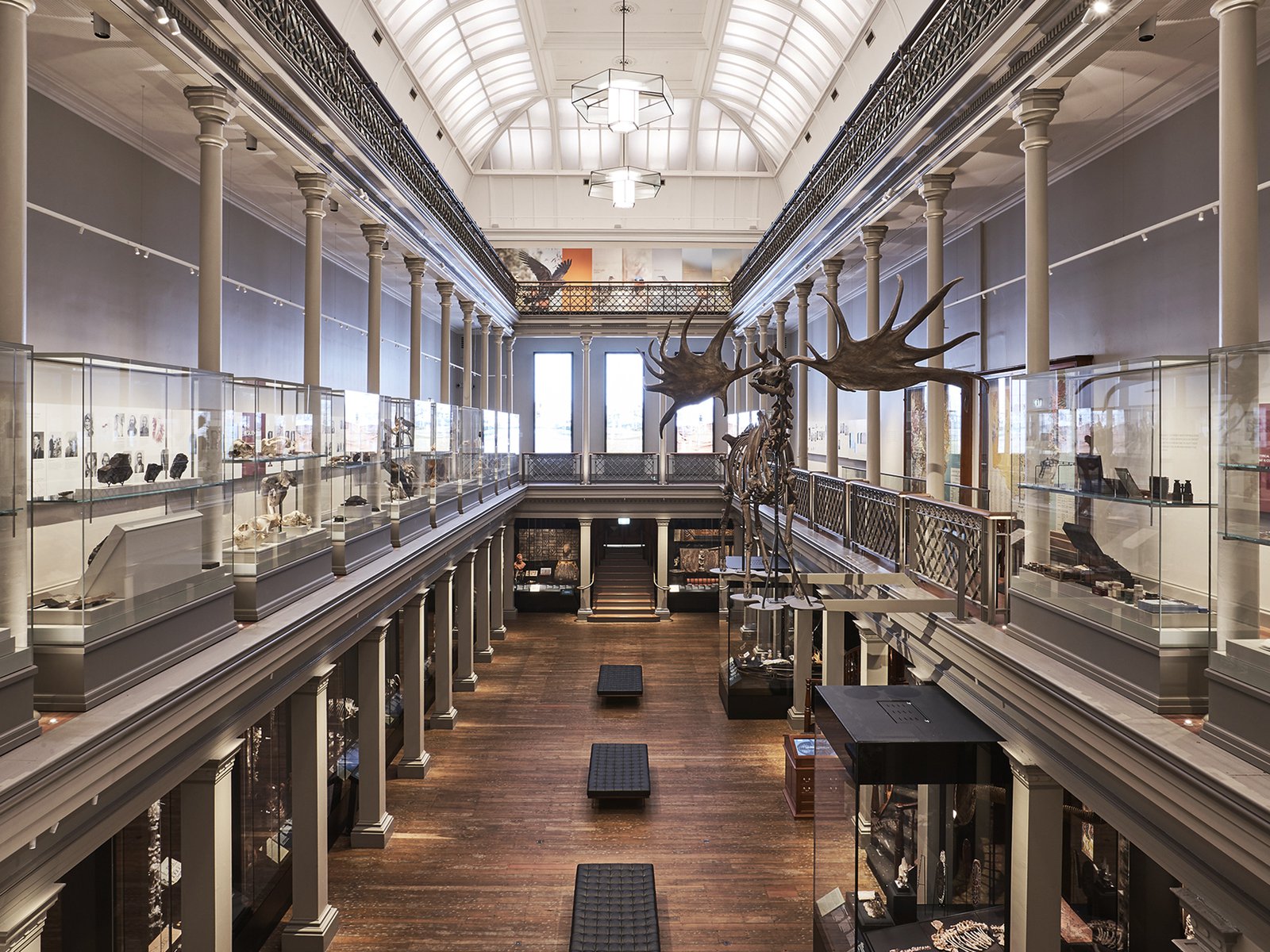Facelift for the Future
Sheldon Teare is rapt in concentration as he uses a mini dental vacuum to suck the dust off every feather on a century-old male peacock that sits more than a metre tall on his desk.
“We wear gloves because some of these animals were preserved using arsenic,” he says. “We also have to ensure every feather is smooth, not ruffled or unzipped.” The final stage is to paint the feathers with water and a thickening agent, using blotting paper to draw off any residual dust.

© Australian Museum
Teare is one of Australian Museum’s six Natural History Conservators preparing, cleaning, restoring and documenting 220 objects for display in the soon-to-be-unveiled exhibition 200 Treasures of the Australian Museum in Australia’s first museum gallery, the Westpac Long Gallery.
Opening 14 October, the exhibition will showcase 100 invaluable treasures from the AM’s world-class collection, and the stories of 100 people who have had a profound influence on the nation.
The 100 objects have been selected not only for their uniqueness, cultural significance, scientific value or beauty but for the captivating stories they tell, when and how they were discovered and their relationships with other items in the museum. An additional 120 complementary specimens will be on display, adding to the richness of these hidden stories.

© Australian Museum
And while our Conservators work on restoring and preserving, Exhibition Project Manager Fran Dorey has been driving the exhibition design, content and planning process since the end of 2014.
“The point is that the gallery is not frozen in the past but has evolved and adapted over 150 years,” she says. “The gallery will pay tribute to the past but embrace the future – enhanced with technology such as video, audio and interactive touch screens.”
Aaron Maestri, the AM’s Exhibition Designer and the project’s visionary, used a 3D printer to create a model the size of a doll’s house of the Westpac Long Gallery, which helped him figure out where and how all the display cases (purpose-built in Italy) will sit.

© Australian Museum
The gallery is a great example of Victorian architecture of the time, similar to the GPO and the grand bank buildings, but the original design has been obscured by additions and alterations over the years,” Maestri says. “While we have worked with a heritage architect to restore the gallery’s original structure, we are definitely bringing the exhibition design into the 21st century; it is lean and modern but retains the solidness of its history. Aaron Maestri
A glimpse of the Treasures
Eric the pliosaur was found in 1987 by opal miner Joe Vida. Pliosaurs are short-necked plesiosaurs, aquatic carnivorous reptiles that lived in the Jurassic and Cretaceous periods (about 200–66 million years ago). Eric’s bones – as well as the tiny fossilised bones of fish inside his stomach – opalised as he was preserved in the sandstone.

© Australian Museum
Archaeologists excavated this Egyptian mummy (below) from a tomb in Thebes (modern-day Luxor). The mummy is wrapped in fragile linen and is lying in a wooden coffin, painted with devotional scenes. Originally, AM scientists believed it contained a man. Then in 2004, a computed tomography (CT) scan at Royal Prince Alfred Hospital revealed the mummy actually held the body of a woman, mummified 2,200 years ago.

© Australian Museum
The First Australian Banknote (below) which reappeared mysteriously in Scotland – is one of an unknown number of notes the Bank of New South Wales issued on its first day of operation on the 8th April 1817. The Sydney Gazette, the colony’s first newspaper, printed the note from a copperplate etching made by a local craftsman-engraver.

© FIC AUSTRALIA
This kipuka or feathered cape (below) was given to Captain Cook on his third – and fatal – Pacific voyage by Ali’i (chief) Kalani’opu’u, as an official welcome to Hawaii in December 1778 or January 1779. Rulers wore this kipuka for ceremonies and in battle. The cape is made from woven olana fibre and its plumage comes from a red-feathered I’iwi honeyeater, a yellow o’o moho and mamo, and a black cockerel.

© Australian Museum
The exhibition will also tell the stories of 100 legendary Australians. A selection committee of people with diverse interests has curated the list, which will be revealed in full at opening, but includes the likes of cricketer Sir Donald Bradman, soprano Dame Nellie Melba and Indigneous olympian Cathy Freeman.
200 Treasures of the Australian Museum in the Westpac Long Gallery will open to the public 14 October 2017.

